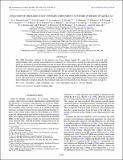EVOLUTION OF THE RADIO-X-RAY COUPLING THROUGHOUT AN ENTIRE OUTBURST OF AQUILA X-1
Author(s)
Miller-Jones, J. C. A.; Sivakoff, G. R.; Altamirano, D.; Tudose, V.; Migliari, S.; Dhawan, V.; Fender, R. P.; Garrett, M. A.; Heinz, Sebastian; Körding, E. G.; Krimm, H. A.; Maitra, D.; Markoff, Sera B.; Paragi, Z.; Rupen, M. P.; Rushton, A.; Russell, D. M.; Sarazin, C. L.; Spencer, R. E.; Linares Alegret, Manuel; Remillard, Ronald A; ... Show more Show less
DownloadMiller-Jones-2010-EVOLUTION OF THE RAD.pdf (761.2Kb)
PUBLISHER_POLICY
Publisher Policy
Article is made available in accordance with the publisher's policy and may be subject to US copyright law. Please refer to the publisher's site for terms of use.
Terms of use
Metadata
Show full item recordAbstract
The 2009 November outburst of the neutron star X-ray binary Aquila X-1 (Aql X-1) was observed with unprecedented radio coverage and simultaneous pointed X-ray observations, tracing the radio emission around the full X-ray hysteresis loop of the outburst for the first time. We use these data to discuss the disk-jet coupling, finding the radio emission to be consistent with being triggered at state transitions, both from the hard to the soft spectral state and vice versa. Our data appear to confirm previous suggestions of radio quenching in the soft state above a threshold X-ray luminosity of ~10% of the Eddington luminosity. We also present the first detections of Aql X-1 with very long baseline interferometry, showing that any extended emission is relatively diffuse and consistent with steady jets rather than arising from discrete, compact knots. In all cases where multi-frequency data were available, the source radio spectrum is consistent with being flat or slightly inverted, suggesting that the internal shock mechanism that is believed to produce optically thin transient radio ejecta in black hole X-ray binaries is not active in Aql X-1.
Date issued
2010-05Department
MIT Kavli Institute for Astrophysics and Space ResearchJournal
Astrophysical Journal. Letters
Publisher
IOP Publishing
Citation
Miller-Jones, J. C. A., G. R. Sivakoff, D. Altamirano, V. Tudose, S. Migliari, V. Dhawan, R. P. Fender, et al. “EVOLUTION OF THE RADIO-X-RAY COUPLING THROUGHOUT AN ENTIRE OUTBURST OF AQUILA X-1.” The Astrophysical Journal 716, no. 2 (May 26, 2010): L109–L114. © 2010 The American Astronomical Society
Version: Final published version
ISSN
2041-8205
2041-8213